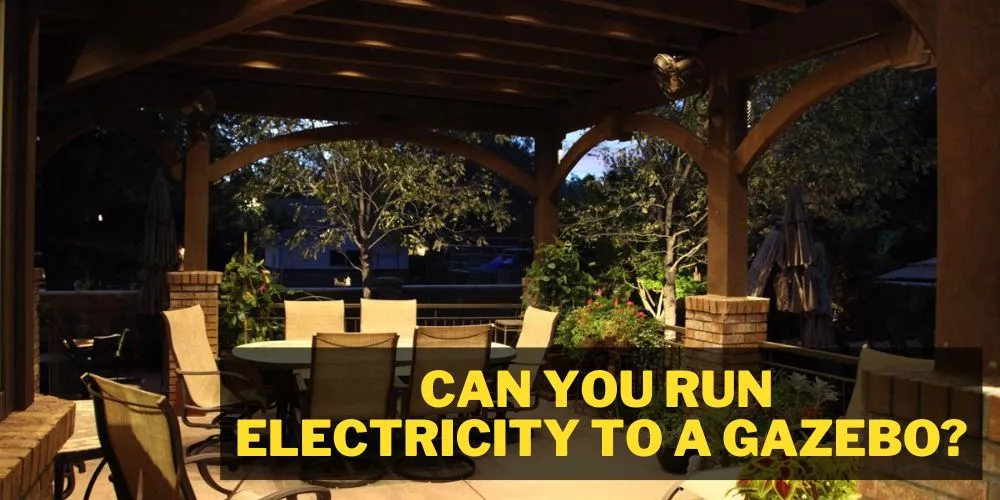Ever looked at your garden and thought, “I wish I could move my gazebo over there?” You’re not alone. Whether it’s to chase the sun, create more space, or because you’re relocating, many people find themselves wondering how to move a gazebo. But let’s be honest; the task can seem daunting. Moving a gazebo is like solving a 3D puzzle – a heavy one, at that. One might encounter logistical issues, potential damages, or even legal requirements.
Moreover, safety considerations are paramount to avoid accidents or damage to your property. In this article, I’ll walk you through a comprehensive, step-by-step process on how to move a gazebo. I’ll also discuss everything you need to know, from assessing feasibility to post-move maintenance.

How to Move a Gazebo (A Step-By-Step Process)
Before we delve into the nitty-gritty, it’s important to highlight that this isn’t a one-person job. Having a friend or two to help can make the process smoother. So grab your tools, gather your team, and get to work. Let’s break down this seemingly enormous task into manageable steps.
Step 1: Assess the Feasibility
Examine the gazebo structure
The first step in moving a gazebo involves a thorough assessment. You need to carefully examine the current gazebo structure. Is it sturdy? Can it withstand the process of disassembly and reassembly? If it’s made of wood, check for signs of rot or infestation that could weaken its structure. For metal gazebos, look for rust or lose joints.

Determine the new location & logistics
Next, determine the new location and figure out the logistics. Consider factors like ground condition, overhead clearance, access for transportation, and even the direction of sunlight. You wouldn’t want your gazebo sitting in a perpetually shaded area, would you?
Ensure legal requirements & permits
Don’t forget about the legal side of things. Moving or setting up a gazebo might require permits in some areas, especially for larger structures. It’s always wise to check in with your local municipality or homeowners association to ensure you’re not breaking any rules.
Step 2: Create A Proper Plan and Prepare Accordingly
Create a detailed moving plan
Once you’ve assessed feasibility, it’s time to create a detailed plan. This includes sketching out your gazebo, noting its dimensions (metric and imperial for convenience), and labelling its parts. This step will save you a lot of guesswork regarding reassembly.
Gather necessary tools & equipment
You’ll also need to gather the necessary tools and equipment. Depending on your gazebo’s design, this might include screwdrivers, wrenches, hammers, a tape measure, a level, and a ladder. Having all your tools before you begin can greatly speed up the process.
Enlist additional help if required
If the gazebo is large, you might need to enlist some extra help. This is not a task you want to tackle alone. Besides, a few extra pairs of hands can make the job safer and more enjoyable.
Secure any required transportation
Lastly, secure transportation. For smaller gazebos, a pickup truck might suffice. You might need to rent a flatbed truck or a trailer for larger structures. Just make sure whatever you can accommodate the gazebo’s dimensions.
Step 3: Dismantle the Gazebo
Remove any detachable parts
Now comes the part where you roll up your sleeves: dismantling the gazebo. Start by removing detachable parts such as the roof, benches, or decorative elements.

Document the disassembly process
Document the disassembly process. It might seem like a hassle, but taking pictures or making notes can be a lifesaver when it comes time to assemble everything. Trust me, your future self will thank you.
Properly label & organize the parts
Label and organize all the parts and hardware. Ziplock bags can be great for keeping screws, bolts, and other small items organized.
Tips for handling fragile or delicate elements
Remember, some parts of your gazebo could be fragile or delicate. Handle these with extra care to prevent damage. If possible, wrap them in bubble wrap or moving blankets for extra protection.
Step 4: Prepare the New Site/Location
Inspect the new location
With your gazebo ready for the big move, it’s time to focus on its new address. Begin by giving the area a good once-over. You must ensure it’s free from any hurdles like rocks, tree branches, or anything else that might be lying around!
Level the ground, if necessary
If your ground seems a little off-kilter, it’s essential to rectify this. A gazebo set up on an unlevel surface can result in stability issues down the road, so take your time to level the ground if needed.
Take measurements & mark the footprint
Once you have a clear, level area, it’s time to bring out your measuring tape. Measure the space and draw out the footprint of the gazebo. This rough sketch will act as a blueprint when you start the reassembly process, so take your time to ensure it’s accurate. It’s a small step that will make the reassembly much smoother, trust me!
Step 5: Transport the Gazebo Safely
Load & secure the gazebo onto the vehicle
Once your new site is ready and waiting, it’s time to move your gazebo. Carefully load the parts onto your vehicle, first with the heaviest pieces. Secure everything tightly to prevent movement or damage during the journey.
Drive with caution to avoid vibrations or shocks
Drive with caution. Sudden brakes or sharp turns could damage your gazebo parts. So take it slow, and remember that it’s better to arrive late and safely rather than early and with a damaged gazebo.
Unload and unpack the gazebo safely
When you arrive, unpack and unload the gazebo parts safely. Again, be mindful of the more fragile elements.
Step 6: Reassemble the Gazebo Properly
Follow the documentation from the disassembly process
Now comes the moment of truth: reassembly. Begin by consulting your documentation from the disassembly process. Start with the base and work up, ensuring proper alignment and stability at each step.

Secure all connections and joints
Secure all connections and joints as you go. This is where your labeling and organization from earlier will pay off.
Test the stability and make adjustments if needed
Once the gazebo is assembled, test its stability. If something seems off, don’t hesitate to make adjustments. It’s much better to catch and fix issues now than to have problems down the line.
Step 7: Some Final Touches and Maintenance Tips
Congratulations! You’ve successfully moved your gazebo. But before you break out the celebratory drinks, there are a few final touches to take care of.
Check for any damages during the move
Inspect the gazebo for any damages that might have occurred during the move if you find any, repair or replace the broken parts immediately.
Apply waterproofing treatments (if required)
You might want to apply some waterproofing treatments to your gazebo, especially if it’s made of wood. This can help prolong its lifespan and keep it looking fresh.
Landscape & enhance the gazebo’s surroundings
Finally, consider landscaping and enhancing your gazebo’s surroundings. Plant some flowers, add some lights, or maybe even a pathway leading up to it. After all, your gazebo deserves to be shown off.
So, there you have it: a comprehensive guide on how to move a gazebo. It might seem like a lot, but remember, the key to a successful move lies in careful planning, proper execution, and a little patience. Happy moving!
Pro Tips for a Successful Gazebo Move

Tip 1: Double-check All Measurements and Dimensions
Accuracy is crucial when moving a gazebo. Misjudging the size or location can lead to all sorts of problems. So, make sure you double-check all measurements, both of the gazebo and its new location. Keep a measuring tape handy at all times.
Tip 2: Capture the Disassembly Process
Having a visual reference can be a lifesaver during reassembly. Make sure to take photographs or even videos during the disassembly process. It will serve as your guide and prevent any assembly mistakes.
Tip 3: Label Each Part for Easy Identification
Imagine assembling a jigsaw puzzle without knowing what the final picture looks like. That’s what reassembling a gazebo without labels can feel like. Label each part during disassembly for a smoother reassembly.
Tip 4: Secure All Loose Parts and Fasteners During Transportation
Small parts like screws and bolts can easily get lost during the move. Ensure all loose parts are secured in a bag or box, and fasten everything tightly on the vehicle.
Tip 5: Conduct a Final Inspection and Test Before Using the Gazebo
Once your gazebo is up, give it a final inspection. Test its stability and double-check all joints and connections. It’s better to be safe than sorry, especially when it comes to a structure you’ll be spending time in.
Frequently Asked Questions (FAQs)
Can I move a gazebo alone, or do I need professional assistance?
Moving a gazebo can be done DIY-style with careful planning. However, due to the complexity and potential risks involved, professional help is often recommended, especially for larger structures.
How long does it take to move a gazebo?
The time to move a gazebo varies greatly depending on size and complexity. Typically, it can range from a few hours to a few days.
Can I move a gazebo without disassembling it?
While it’s technically possible to move smaller, lighter gazebos without disassembling them, it’s generally safer and more practical to disassemble larger ones before moving.
How much does it cost to move a gazebo?
Costs vary based on the gazebo’s size, the distance of the move, and whether professional help is hired. It can range from a few hundred dollars for small DIY moves to several thousand for large, professional ones.
Conclusion:
And there you have it – the comprehensive guide to moving a gazebo. We’ve covered everything from assessing feasibility to applying the final touches. Remember, the secret to a successful move lies in meticulous planning, keen attention to safety, and patience. While moving a gazebo can be a DIY endeavor, don’t hesitate to call in professionals if it feels overwhelming.
There’s no shame in ensuring the job gets done safely and correctly. We hope that this guide has been helpful. You can read about similar topics here on our website. Check back again soon for more. Until then, happy gazebo moving!


